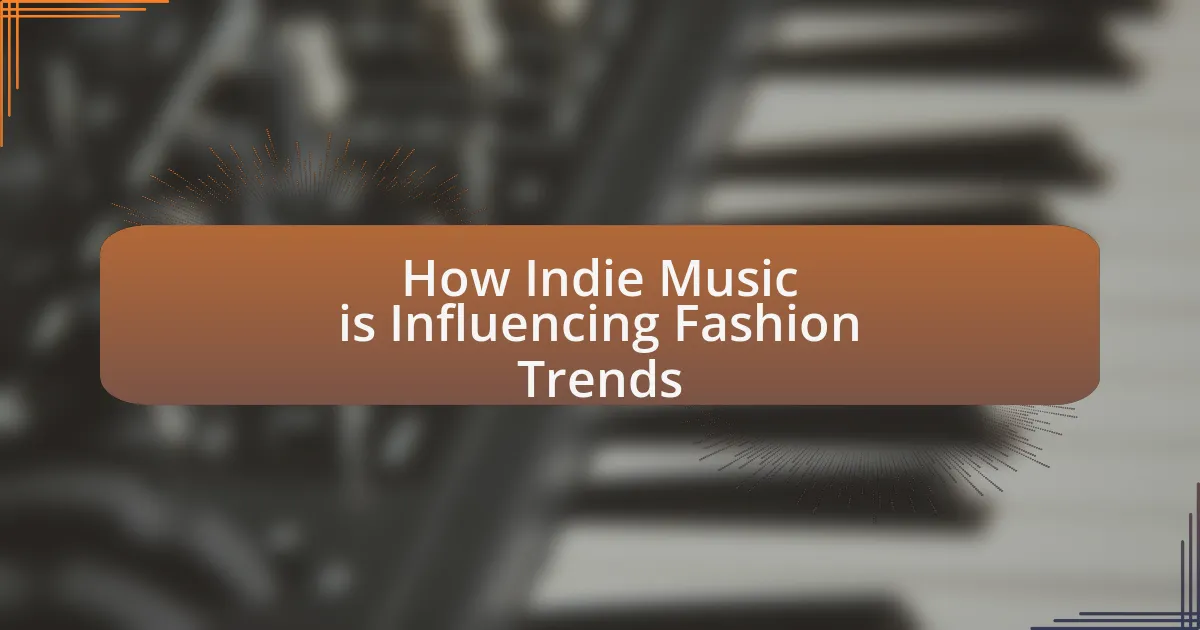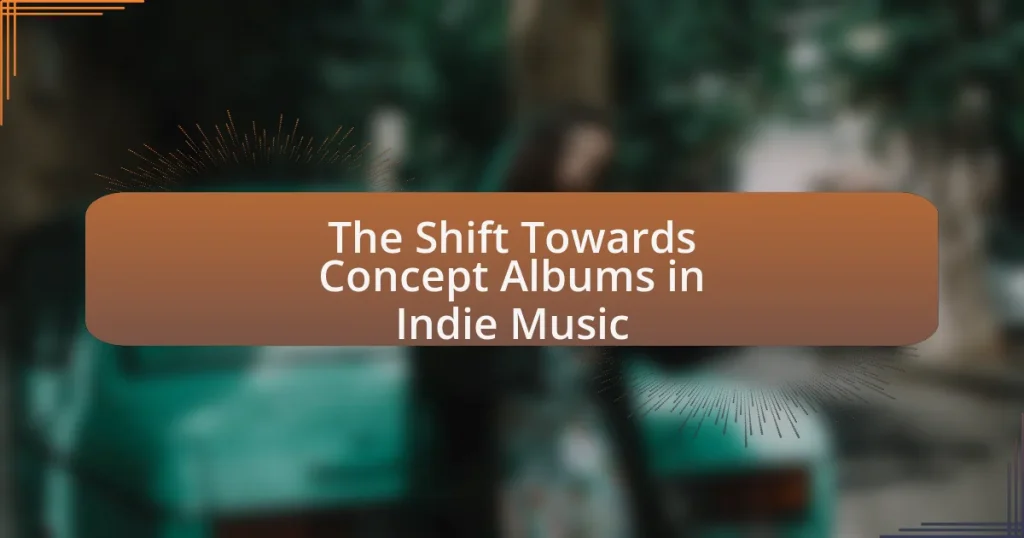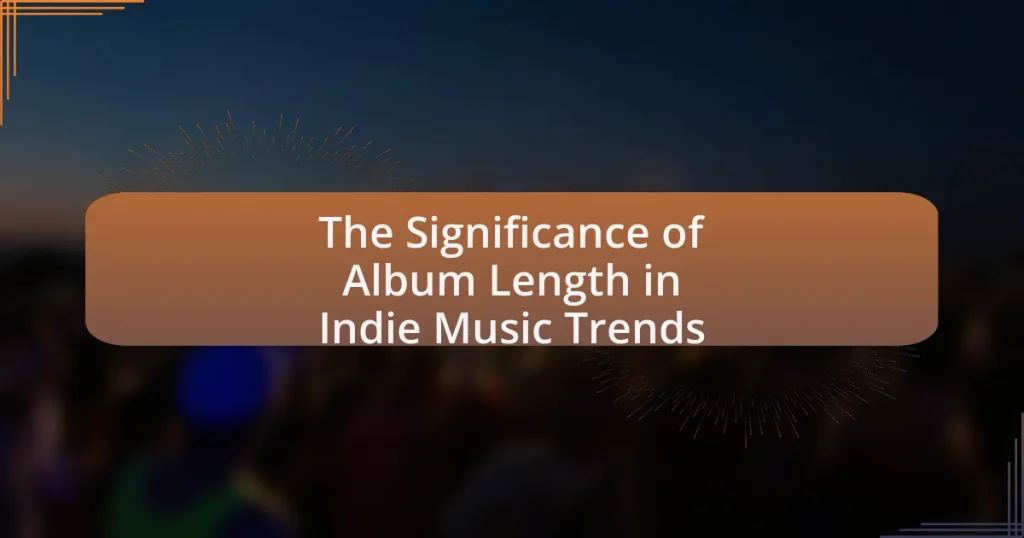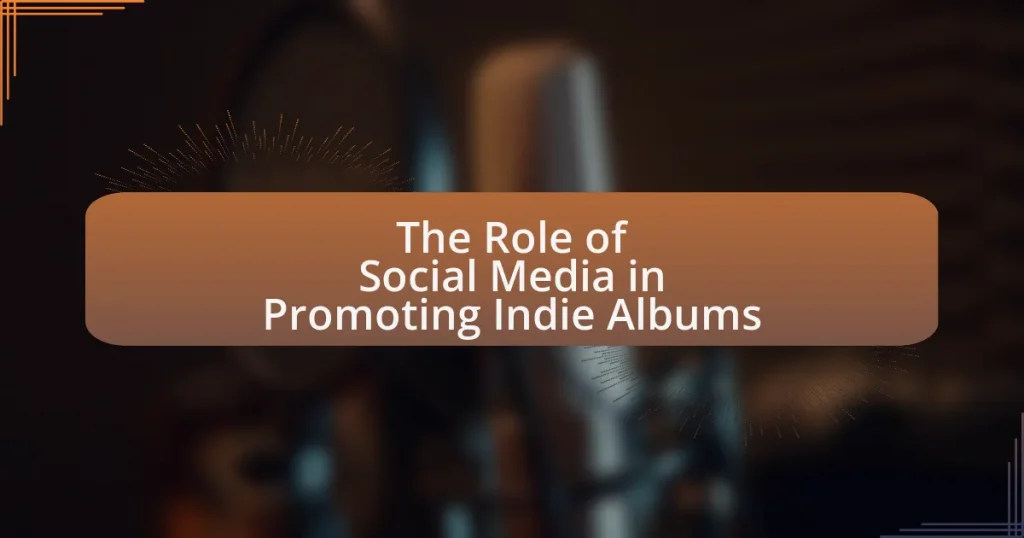Indie music is significantly influencing fashion trends by promoting a distinctive style that emphasizes individuality and creativity. Artists in the indie genre often showcase unique clothing choices that blend vintage, eclectic, and DIY elements, impacting both fans and the broader fashion landscape. Key characteristics of indie music, such as authenticity and a rejection of mainstream aesthetics, drive trends like thrift shopping and the resurgence of retro-inspired clothing. Music festivals serve as platforms for showcasing these fashion trends, while social media accelerates their spread, allowing indie artists to influence streetwear styles and promote sustainable fashion practices. Understanding the roots of indie fashion trends reveals the cultural movements that shape these styles, highlighting the importance of individuality and self-expression in the indie music community.
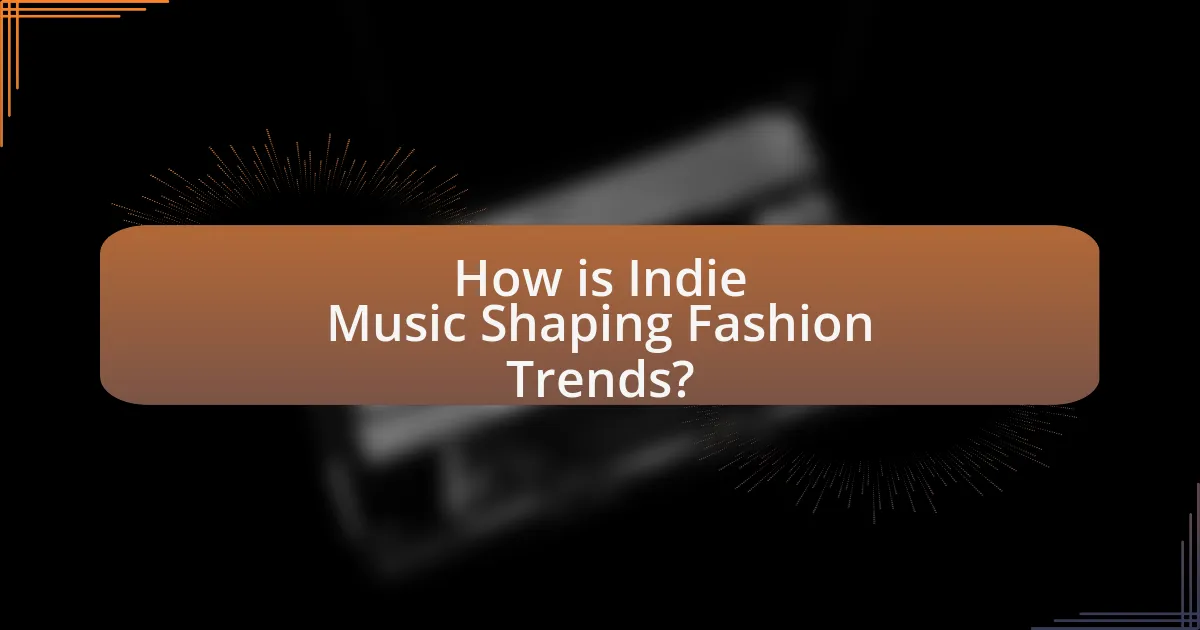
How is Indie Music Shaping Fashion Trends?
Indie music is shaping fashion trends by promoting a distinctive style that emphasizes individuality and creativity. Artists within the indie genre often showcase unique clothing choices that blend vintage, eclectic, and DIY elements, influencing fans and the broader fashion landscape. For instance, the rise of bands like Arctic Monkeys and Tame Impala has led to increased popularity of retro-inspired clothing, such as high-waisted jeans and graphic tees. This influence is evident in fashion retailers who frequently draw inspiration from indie aesthetics, resulting in collections that reflect the genre’s emphasis on personal expression and non-conformity.
What are the key characteristics of Indie Music that influence fashion?
Indie music is characterized by its emphasis on authenticity, individuality, and a DIY ethos, which significantly influences fashion trends. The genre often promotes a rejection of mainstream aesthetics, leading to unique and eclectic styles that prioritize personal expression over commercial appeal. For instance, artists in the indie scene frequently adopt vintage clothing, thrifted items, and handmade accessories, reflecting a desire for originality and sustainability. This trend is supported by the rise of social media platforms, where indie musicians showcase their distinctive looks, further inspiring fans and fashion enthusiasts to embrace similar styles. The fusion of music and fashion in the indie scene is evident in events like music festivals, where attendees often mirror the artists’ fashion choices, creating a vibrant culture of self-expression that challenges conventional fashion norms.
How do the aesthetics of Indie Music artists reflect in their fashion choices?
Indie music artists often reflect their aesthetics in fashion choices through a blend of vintage, eclectic, and personalized styles. This is evident in their preference for thrifted clothing, unique accessories, and a mix of high and low fashion, which emphasizes individuality and authenticity. For instance, artists like Florence Welch and Sufjan Stevens are known for their distinctive looks that combine retro elements with contemporary trends, showcasing a deliberate departure from mainstream fashion norms. This approach not only highlights their artistic identity but also influences their fan base, encouraging a broader acceptance of diverse fashion expressions within the indie music community.
What role do music festivals play in showcasing Indie fashion trends?
Music festivals play a significant role in showcasing Indie fashion trends by providing a platform for attendees to express their unique styles and creativity. These events attract a diverse audience that often embraces eclectic and alternative fashion choices, reflecting the Indie music ethos of individuality and non-conformity. For instance, festivals like Coachella and Glastonbury have become renowned for their vibrant street style, where festival-goers often wear handmade, vintage, or DIY clothing, which aligns with the Indie aesthetic. This visibility helps to popularize Indie fashion trends, as media coverage and social media platforms amplify these styles, influencing broader fashion markets.
Why is the relationship between Indie Music and fashion significant?
The relationship between Indie Music and fashion is significant because it reflects a cultural movement that emphasizes individuality and self-expression. Indie musicians often adopt unique styles that challenge mainstream fashion norms, influencing their fans and the broader fashion landscape. For instance, the rise of the DIY aesthetic in the 2000s, popularized by bands like The Strokes and Arctic Monkeys, led to a resurgence of vintage clothing and thrift shopping, impacting retail trends. This interplay between music and fashion not only shapes personal identity but also drives trends in the fashion industry, as seen in collaborations between indie artists and fashion brands, further solidifying their cultural relevance.
How does Indie Music challenge mainstream fashion norms?
Indie music challenges mainstream fashion norms by promoting individuality and eclectic styles that often reject commercial trends. Artists within the indie genre frequently embrace vintage clothing, DIY aesthetics, and unique accessories, which contrast sharply with the polished, mass-produced looks prevalent in mainstream fashion. For instance, the rise of indie bands in the 2000s, such as The Strokes and Arctic Monkeys, showcased a casual yet distinctive style that emphasized personal expression over brand conformity. This shift has influenced fans and the broader fashion landscape, leading to a resurgence of thrift shopping and a preference for non-traditional fashion choices, thereby undermining the uniformity often seen in mainstream fashion.
What cultural movements are associated with Indie Music and fashion?
Indie music and fashion are primarily associated with cultural movements such as the DIY (Do It Yourself) ethos, counterculture, and alternative lifestyle movements. The DIY ethos emerged in the late 1970s and 1980s, promoting self-production and independence from mainstream music and fashion industries, which is evident in the way indie artists often produce their own music and merchandise. Counterculture movements, particularly in the 1960s and 1970s, influenced indie music by challenging societal norms and embracing individuality, which is reflected in the eclectic and often non-conformist fashion choices of indie artists and fans. Additionally, the alternative lifestyle movement, which values authenticity and personal expression, has shaped both indie music and fashion, leading to unique styles that prioritize creativity over commercial trends.
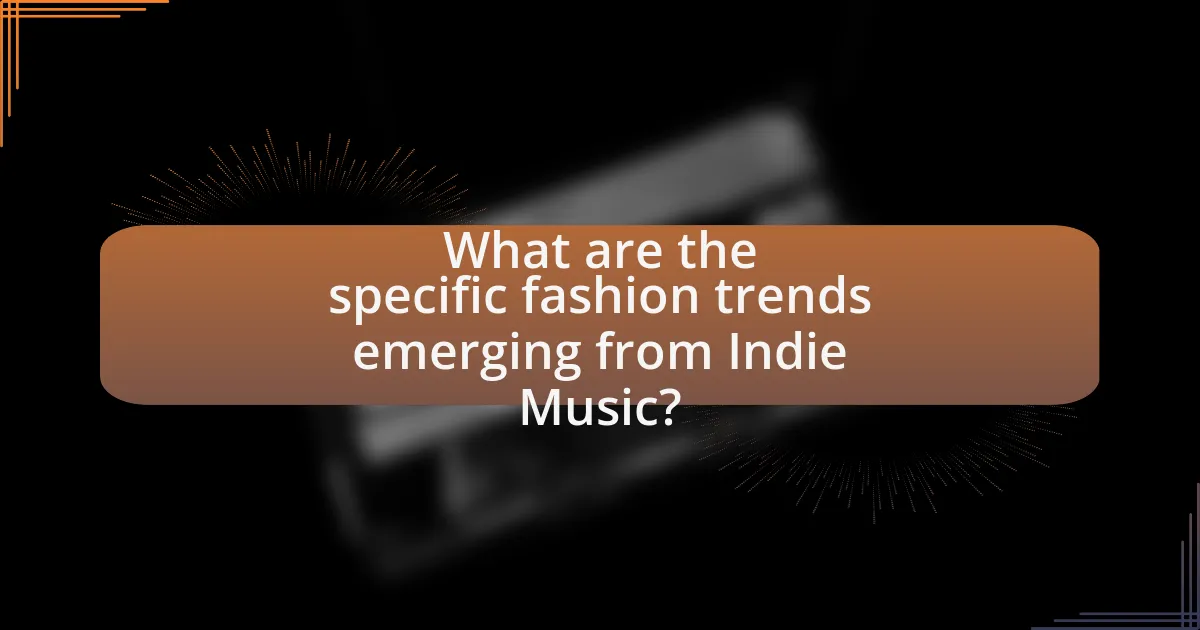
What are the specific fashion trends emerging from Indie Music?
Indie music is driving specific fashion trends characterized by vintage aesthetics, eclectic layering, and a focus on individuality. Artists within the indie genre often embrace thrifted clothing, retro patterns, and unique accessories, which reflect a DIY ethos and a rejection of mainstream fashion norms. For example, the resurgence of 90s grunge, featuring oversized flannel shirts, combat boots, and distressed denim, has been popularized by indie bands and artists. Additionally, the use of bold colors and unconventional silhouettes, such as oversized jackets and statement hats, is prevalent among indie musicians, showcasing a blend of comfort and creativity. This trend is supported by the growing visibility of indie artists on social media platforms, where their distinctive styles influence fans and fashion enthusiasts alike.
How do Indie artists influence streetwear styles?
Indie artists influence streetwear styles by integrating unique aesthetics and personal narratives into their fashion choices, which resonate with their fan base. This influence is evident in the rise of brands that collaborate with indie musicians, such as the partnership between the band Tame Impala and Adidas, which showcased how music can directly shape clothing lines. Additionally, indie artists often promote thrifted and vintage clothing, encouraging sustainable fashion practices that align with the values of their audience. This trend is supported by the growing popularity of platforms like Instagram, where indie musicians showcase their outfits, further solidifying their role as trendsetters in the streetwear scene.
What are the most popular clothing items inspired by Indie musicians?
The most popular clothing items inspired by Indie musicians include vintage band tees, oversized denim jackets, and thrifted dresses. Vintage band tees are often worn by fans to showcase their favorite artists, reflecting a casual yet stylish aesthetic. Oversized denim jackets, frequently seen in Indie music videos, provide a relaxed look that resonates with the genre’s ethos of authenticity and individuality. Thrifted dresses, characterized by unique patterns and styles, align with the Indie movement’s embrace of sustainability and personal expression. These items collectively illustrate how Indie musicians influence fashion trends by promoting a blend of nostalgia, comfort, and individuality.
How do accessories play a role in Indie fashion trends?
Accessories are crucial in shaping Indie fashion trends by allowing individuals to express their unique identities and creativity. In the Indie fashion scene, accessories such as vintage jewelry, handmade bags, and eclectic hats serve as focal points that enhance personal style and differentiate wearers from mainstream fashion. The emphasis on individuality in Indie culture encourages the use of accessories to create layered, personalized looks that reflect personal stories and artistic influences. This trend is supported by the rise of DIY culture within the Indie community, where many individuals craft or curate their accessories, further emphasizing the importance of personal expression in fashion.
What impact does social media have on the spread of Indie fashion trends?
Social media significantly accelerates the spread of Indie fashion trends by providing a platform for immediate visibility and engagement. Platforms like Instagram and TikTok allow independent designers and influencers to showcase their unique styles to a global audience, facilitating rapid trend adoption. For instance, a study by the Pew Research Center indicates that 72% of teenagers use Instagram, making it a crucial space for fashion discovery. Additionally, the viral nature of social media enables trends to gain traction quickly, as users share and replicate styles, creating a community-driven fashion ecosystem. This interconnectedness fosters a culture where Indie fashion can thrive, as seen in the rise of micro-influencers who promote niche brands and styles, further validating the impact of social media on Indie fashion trends.
How do platforms like Instagram and TikTok promote Indie fashion?
Platforms like Instagram and TikTok promote Indie fashion by providing a visual and interactive space for independent designers and brands to showcase their unique styles. These platforms enable users to share content through photos, videos, and stories, which helps Indie fashion reach a broader audience. For instance, TikTok’s algorithm favors engaging content, allowing Indie fashion creators to gain visibility quickly, often leading to viral trends. Additionally, Instagram’s features like shopping tags and influencer partnerships facilitate direct sales and brand collaborations, further enhancing the exposure of Indie fashion. According to a 2021 report by Statista, 54% of users on TikTok discover new brands through the platform, illustrating its effectiveness in promoting niche fashion markets.
What are the challenges of maintaining authenticity in Indie fashion on social media?
Maintaining authenticity in Indie fashion on social media is challenging due to the pressure to conform to mainstream trends and the risk of commercialization. Indie fashion, which thrives on individuality and self-expression, often faces dilution when brands or influencers adopt these styles for mass appeal, leading to a loss of genuine representation. Additionally, the curated nature of social media can create a disconnect between the real-life experiences of Indie fashion enthusiasts and the idealized images presented online. This discrepancy can undermine the authenticity that the Indie fashion community values, as seen in studies showing that 70% of consumers prefer brands that reflect their personal values and authenticity.
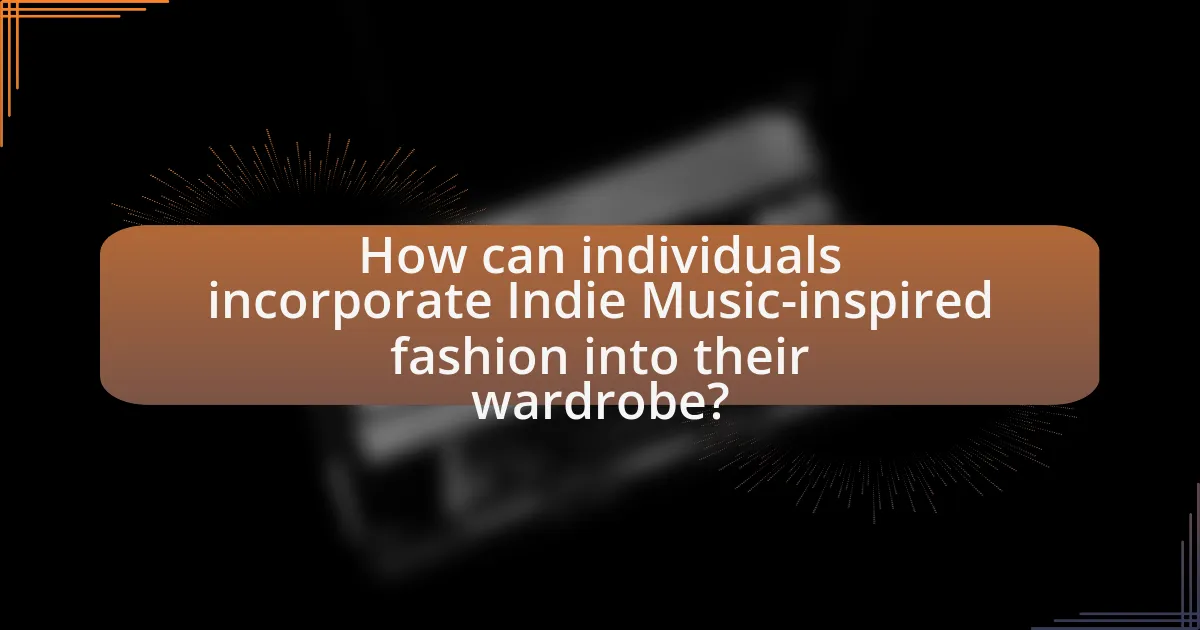
How can individuals incorporate Indie Music-inspired fashion into their wardrobe?
Individuals can incorporate Indie Music-inspired fashion into their wardrobe by selecting vintage clothing, layering unique pieces, and accessorizing with handmade or artisanal items. Vintage clothing, often characterized by its eclectic styles, allows individuals to express individuality, a core principle of indie culture. Layering different textures and patterns, such as combining oversized sweaters with fitted jeans or flowy skirts, creates a relaxed yet stylish look that reflects the indie aesthetic. Additionally, accessorizing with handmade jewelry, beanies, or scarves can enhance the overall outfit, emphasizing the artisanal aspect prevalent in indie music scenes. This approach not only aligns with the indie ethos of creativity and self-expression but also supports sustainable fashion practices by promoting the use of second-hand and locally made items.
What are some tips for blending Indie fashion with personal style?
To blend Indie fashion with personal style, start by incorporating unique, vintage, or handmade pieces that reflect your individuality. This approach aligns with the Indie aesthetic, which often emphasizes originality and self-expression. For instance, mixing thrifted items with contemporary pieces can create a distinctive look that showcases personal flair. Additionally, layering different textures and patterns can enhance the eclectic nature of Indie fashion while allowing personal preferences to shine through. Emphasizing accessories, such as statement jewelry or hats, can further personalize the outfit, making it a true reflection of one’s style.
How can thrift shopping enhance an Indie-inspired wardrobe?
Thrift shopping can enhance an Indie-inspired wardrobe by providing unique, vintage pieces that reflect individual style and creativity. This approach aligns with the Indie aesthetic, which values originality and personal expression over mainstream fashion trends. Thrift stores often carry a diverse range of clothing from various eras, allowing individuals to curate a wardrobe that stands out and showcases their personality. Additionally, the affordability of thrifted items enables shoppers to experiment with different styles without significant financial commitment, further encouraging the exploration of unique fashion combinations that are characteristic of the Indie scene.
What are the best brands to explore for Indie fashion pieces?
The best brands to explore for Indie fashion pieces include Free People, Urban Outfitters, and ASOS. Free People is known for its bohemian styles that resonate with the Indie aesthetic, while Urban Outfitters offers a mix of vintage-inspired and contemporary pieces that appeal to the Indie crowd. ASOS provides a wide range of affordable Indie fashion options, catering to diverse tastes and styles. These brands have established themselves in the market by consistently aligning their collections with the values and aesthetics of the Indie music scene, making them popular choices for those seeking Indie fashion.
What are common misconceptions about Indie fashion?
Common misconceptions about Indie fashion include the belief that it is solely about thrift shopping and vintage clothing. While thrift stores and vintage pieces are often associated with Indie fashion, the style also embraces contemporary designers and unique, original creations that reflect individual expression. Additionally, some people think Indie fashion lacks cohesion or is merely a haphazard mix of styles; however, it often features a distinct aesthetic that combines eclectic influences with a focus on personal identity. This is evident in the rise of independent brands that prioritize craftsmanship and sustainability, which are key elements of the Indie fashion movement.
How does Indie fashion differ from other music-inspired styles?
Indie fashion differs from other music-inspired styles primarily through its emphasis on individuality and eclecticism. While genres like punk or hip-hop often adhere to specific aesthetics and cultural symbols, indie fashion embraces a mix of vintage, thrifted, and handmade items, allowing for personal expression. This approach is rooted in the indie music scene’s DIY ethos, which values authenticity and creativity over commercial trends. For example, indie artists often promote unique fashion choices that reflect their personal stories, contrasting with mainstream styles that may prioritize brand recognition and uniformity.
Why is it important to understand the roots of Indie fashion trends?
Understanding the roots of Indie fashion trends is crucial because it reveals the cultural and social influences that shape these styles. Indie fashion often emerges from a reaction against mainstream trends, reflecting values such as individuality, creativity, and authenticity. For instance, the rise of Indie fashion in the early 2000s was closely tied to the DIY ethos of the Indie music scene, where artists and fans sought to express their identities outside of commercial norms. This connection highlights how Indie fashion serves as a visual representation of the broader cultural movements within the Indie music community, making it essential for fashion enthusiasts and industry professionals to grasp these origins to appreciate the significance and evolution of the trends.
